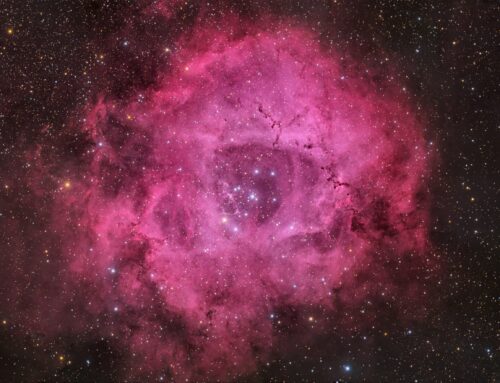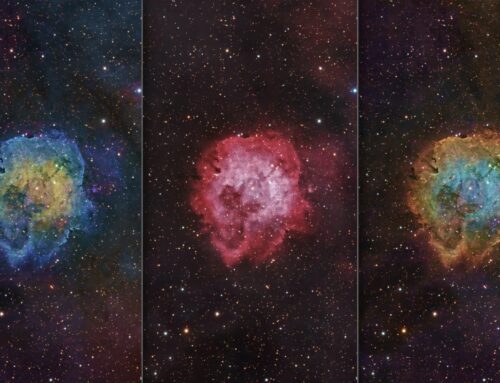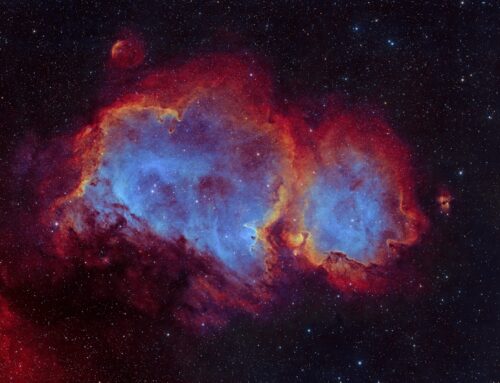NGC 7023 – The Iris Nebula
 Click image for full size version
Click image for full size version
October 20, 2024
This is NGC 7023, also known as the Iris Nebula and Caldwell 4. Actually, the nomenclature is a bit more complicated than that. The designation ‘NGC 7023’ refers not to the nebula, but to the open cluster concentrated in the dark area to the right of the nebula’s central star. The Iris Nebula is catalogued as LBN 487. It is primarily a reflection nebula, with the the blue hues coming from light reflected off soot/dust around the bright star. There are also some subtle pink structures that are due to H-alpha emissions.
The Iris Nebula is within our own Milky Way galaxy, about 1,300 light years from Earth. It has a diameter of about 6 light years and covers a little more than half the Moon’s width on the sky, at about 18′ across. However, the brown dust extends much further. The bright star at the centre of the nebula is called HD 200775 and is easily visible in binoculars, but I have found the nebula very challenging to see visually. I have imaged the Iris Nebula region many times over the years, but this is the closest and deepest shot so far.
Tekkies:
Acquisition, focusing, and control of Paramount MX mount with N.I.N.A., TheSkyX. Guiding with PHD2. Primalucelab low-profile 2″ Essato focuser, ARCO rotator and Giotto flat panel. Equipment control with PrimaLuce Labs Eagle 4 Pro computer. All pre-processing and processing in PixInsight. Acquired from my SkyShed in Guelph. Data acquired under moderate to no moonlight, good transparency and average seeing September 29 – October 5, 2024.
Celestron 14″ EDGE HD telescope at f/11 (3,940 mm focal length) and QHY600M camera binned 2×2 with Optolong filters.
54 x 5m Red = 4hr 30m
55 x 5m Green = 4hr 35m
48 x 5m Blue = 4hr 00m
32 x 5m Lum = 2hr40m
Total: 15hr 45m
Image scale 0.4 arcsec per pixel
Preprocessing: The WeightedBatchPreProcessing script was used to perform calibration, cosmetic correction, weighting, registration, local normalization, integration and Drizzle integration of all frames.
RGB master: An RGB image was made from the Red, Green and Blue masters using ChannelCombination in RGB mode.
Synthetic Luminance: A SynthL was made by integrating the four masters, weighted by SNR, with no pixel rejection.
Gradient Removal: DBE was used to remove gradients from the RGB and SynthL masters.
Colour Calibration: ColorCalibration was used to calibrate the RGB master.
Deconvolution: BlurXterminator was applied to the RGB and SynthL masters with Automatic psf , star sharpening set to 0.5, and non-stellar set to 0.9.
Linear Noise Reduction: NoiseXterminator was applied to the RGB and SynthL masters with settings Amount=0.9 and Detail=0.15
Stretching: HistogramTransformation was applied to the RGB and SynthL masters to make pleasing images. Approximate background level after stretch was 0.11 for SynthL and 0.09 for RGB.
Nonlinear Processing
Combinining SynthL and RGB: LRGBCombination was used to replace the lightness channel of the RGB image with the SynthL.
Star Removal: StarXterminator was used to remove the stars from the SynthLRGB master, with default settings, except Large Overlap was selected.
Nonlinear Noise Reduction: NoiseXterminator was used to reduce noise in the background areas of the SynthLRGB master with Amount=0.9 and Detail=0.15.
Re-stretch: HistogramTransformation was used to boost contrast by moving the dark point to the toe of the histogram and slightly decreasing the mid-point slider.
Contrast Enhancement: LocalHistogramEqualization was applied twice. A Contrast Limit of 1.5 and 1 iteration was used for each LHE application (scale 150, strength 0.25; scale 50, strength 0.25).
Sharpening: MultiscaleMedianTransform was applied. (Layers 2 – 4 with strengths of 0.06, 0.06, and 0.03, respectively), using a mask to select only the brightest parts of the image.
Contrast, Brightness and Colour: Background and nebula brightness, contrast, hue and saturation were adjusted in several iterations using Juergen Terpe‘s CreateHDRImage and SelectiveColorCorrection scripts, as well as ExponentialTransformation and CurvesTransformation, with masks as required.
Stars-only steps: ChannelExtraction was used to extract the Lightness channel from the stars-only image. This was then used as a star mask to select stars and protect the background of the stars-only image.. CurvesTransformation Saturation slider was used to boost colour in the stars through the mask.
Star Restoration: PixelMath expression combine(starless, stars, op_screen()) was used to combine the starless SynthLRGB starless image with the stars-only image.
Final Steps: Background, nebula, and star brightness, contrast, hue, and saturation were adjusted in several iterations using CurvesTransformation with masks as required. ICCProfileTransformation (sRGB IEC61966-2.1; Relative Colorimetric with black point compensation) was applied prior to saving as a jpg. The finder chart was made using the FindingChart process.







Leave A Comment